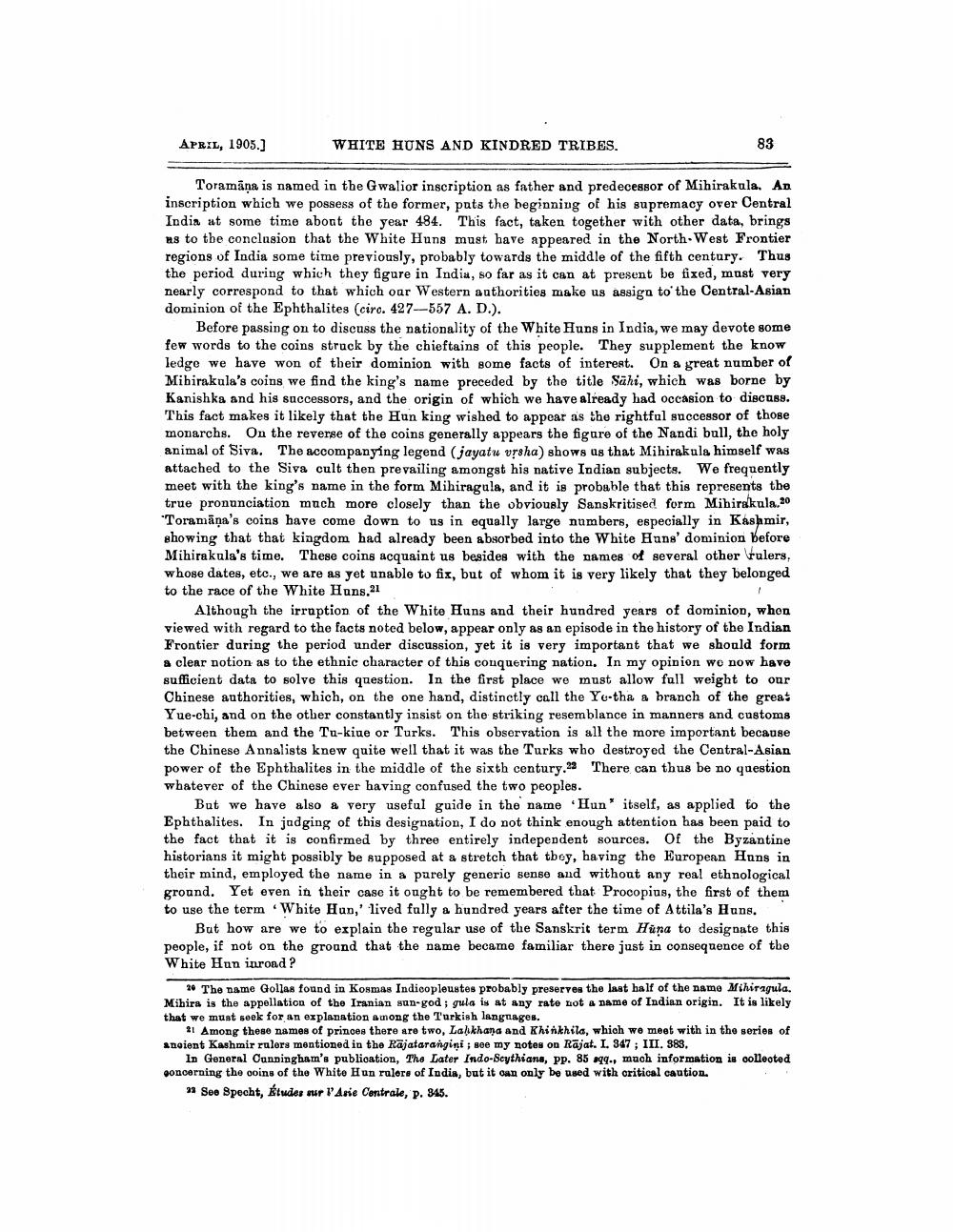________________
APRIL, 1905.)
WHITE HUNS AND KINDRED TRIBES.
Toramana is named in the Gwalior inscription as father and predecessor of Mihirakula. An inscription which we possess of the former, puts the beginning of his supremacy over Central India at some time about the year 484. This fact, taken together with other data, brings as to the conclusion that the White Huns must have appeared in the North-West Frontier regions of India some time previously, probably towards the middle of the fifth century. Thus the period during which they figure in India, so far as it can at present be fixed, must very nearly correspond to that which oar Western authorities make us assiga to the Central-Asian dominion of the Ephthalites (ciro. 427--557 A. D.).
Before passing on to discuss the nationality of the White Huns in India, we may devote some few words to the coins struck by the chieftains of this people. They supplement the know ledge we have won of their dominion with some facts of interest. On a great number of Mihirakula's coins we find the king's name preceded by the title Sähi, which was borne by Kanishka and his successors, and the origin of which we have already had occasion to discuss. This fact makes it likely that the Hun king wished to appear as the rightful successor of those monarchs. On the reverse of the coins generally appears the figure of the Nandi bull, the holy animal of Siva. The accompanying legend (jayatu vrsha) shows us that Mihirakula himself was attached to the Siva cult then prevailing amongst his native Indian subjects. We frequently meet with the king's name in the form Mihiragula, and it is probable that this represents the true pronunciation much more closely than the obviously Sanskritised form Mihirakula.20 "Toramāņa's coins have come down to us in equally large numbers, especially in Kashmir, showing that that kingdom had already been absorbed into the White Hans' dominion before Mihirakula's time. These coins acquaint us besides with the names of several other rulers, whose dates, etc., we are as yet unable to fix, but of whom it is very likely that they belonged to the race of the White Huns.21
Although the irruption of the White Huns and their hundred years of dominion, when viewed with regard to the facts noted below, appear only as an episode in the history of the Indian Frontier during the period under discussion, yet it is very important that we should form a clear notion as to the ethnic character of this conquering nation. In my opinion we now have sufficient data to solve this question. In the first place we must allow full weight to our Chinese authorities, which, on the one hand, distinctly call the Yo-tha a branch of the great Yue-chi, and on the other constantly insist on the striking resemblance in manners and customs between them and the Tu-kine or Turks. This observation is all the more important because the Chinese Annalists knew quite well that it was the Turks who destroyed the Central-Asian power of the Ephthalites in the middle of the sixth century. There can thus be no question whatever of the Chinese ever having confused the two peoples.
But we have also a very useful guide in the name Hun" itself, as applied to the Ephthalites. In judging of this designation, I do not think enough attention has been paid to the fact that it is confirmed by three entirely independent sources. Of the Byzantine historians it might possibly be supposed at a stretch that they, having the European Hans in their mind, employed the name in a parely generic sense and without any real ethnological ground. Yet even in their case it ought to be remembered that Procopius, the first of them to use the term White Hun,' 'lived fully a hundred years after the time of Attila's Huns.
But how are we to explain the regular use of the Sanskrit term Hüpa to designate this people, if not on the ground that the name became familiar there just in consequence of the White Hun inroad?
2. The name Gollas found in Kosmas Indicopleustes probably preserves the last half of the namo Mihiragula. Mihira is the appellation of the Iranian sun-god; gula is at any rate not a name of Indian origin. It is likely that we must seek for an explanation among the Turkish languages.
21 Among these names of princes there are two, Lahkhana and Khinkhila, which we meet with in the series of angient Kashmir rulors mentioned in the Rajatarangini, see my notes on Rajat. I. 347; III. 388.
In General Cunningham's publioation, The Later Indo-Scythians, pp. 85 -99., much information is collected concerning the coins of the White Hun rulere of India, but it can only be used with critical caution.
12 See Specht, Études sur l'Asie Centrale, p. 345.




